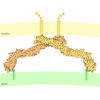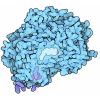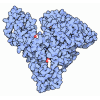[English] 日本語
 Yorodumi
Yorodumi- PDB-1eg4: STRUCTURE OF A DYSTROPHIN WW DOMAIN FRAGMENT IN COMPLEX WITH A BE... -
+ Open data
Open data
- Basic information
Basic information
| Entry | Database: PDB / ID: 1eg4 | ||||||
|---|---|---|---|---|---|---|---|
| Title | STRUCTURE OF A DYSTROPHIN WW DOMAIN FRAGMENT IN COMPLEX WITH A BETA-DYSTROGLYCAN PEPTIDE | ||||||
 Components Components |
| ||||||
 Keywords Keywords | STRUCTURAL PROTEIN / EF-hand like domain / WW domain / Polyproline type II (PPII) helix | ||||||
| Function / homology |  Function and homology information Function and homology informationDefective POMT2 causes MDDGA2, MDDGB2 and MDDGC2 / Defective POMT1 causes MDDGA1, MDDGB1 and MDDGC1 / muscle attachment / dystroglycan complex / nerve maturation / Defective POMGNT1 causes MDDGA3, MDDGB3 and MDDGC3 / retrograde trans-synaptic signaling by trans-synaptic protein complex / regulation of muscle system process / O-linked glycosylation / regulation of cellular response to growth factor stimulus ...Defective POMT2 causes MDDGA2, MDDGB2 and MDDGC2 / Defective POMT1 causes MDDGA1, MDDGB1 and MDDGC1 / muscle attachment / dystroglycan complex / nerve maturation / Defective POMGNT1 causes MDDGA3, MDDGB3 and MDDGC3 / retrograde trans-synaptic signaling by trans-synaptic protein complex / regulation of muscle system process / O-linked glycosylation / regulation of cellular response to growth factor stimulus / syntrophin complex / contractile ring / cardiac muscle cell action potential / calcium-dependent cell-matrix adhesion / morphogenesis of an epithelial sheet / regulation of skeletal muscle contraction / microtubule anchoring / synaptic signaling / dystrophin-associated glycoprotein complex / laminin-1 binding / response to denervation involved in regulation of muscle adaptation / cell-substrate junction / peptide biosynthetic process / motile cilium assembly / photoreceptor ribbon synapse / nerve development / basement membrane organization / dystroglycan binding / regulation of skeletal muscle contraction by regulation of release of sequestered calcium ion / positive regulation of myelination / cellular response to cholesterol / vinculin binding / EGR2 and SOX10-mediated initiation of Schwann cell myelination / regulation of sodium ion transmembrane transport / branching involved in salivary gland morphogenesis / Formation of the dystrophin-glycoprotein complex (DGC) / skeletal muscle tissue regeneration / costamere / commissural neuron axon guidance / myelination in peripheral nervous system / muscle cell development / regulation of calcium ion transmembrane transport / neuron projection terminus / node of Ranvier / Striated Muscle Contraction / filopodium membrane / angiogenesis involved in wound healing / axon regeneration / structural constituent of muscle / positive regulation of cell-matrix adhesion / muscle organ development / muscle cell cellular homeostasis / myosin binding / response to muscle activity / maintenance of blood-brain barrier / regulation of synapse organization / epithelial tube branching involved in lung morphogenesis / nitric-oxide synthase binding / regulation of neurotransmitter receptor localization to postsynaptic specialization membrane / alpha-actinin binding / membrane protein ectodomain proteolysis / positive regulation of oligodendrocyte differentiation / basement membrane / Non-integrin membrane-ECM interactions / plasma membrane raft / ECM proteoglycans / neuron development / postsynaptic cytosol / regulation of cardiac muscle contraction by regulation of the release of sequestered calcium ion / heart morphogenesis / skeletal muscle tissue development / laminin binding / cardiac muscle contraction / negative regulation of MAPK cascade / regulation of release of sequestered calcium ion into cytosol by sarcoplasmic reticulum / response to muscle stretch / extracellular matrix organization / positive regulation of neuron differentiation / negative regulation of phosphatidylinositol 3-kinase/protein kinase B signal transduction / tubulin binding / SH2 domain binding / regulation of heart rate / nuclear periphery / axon guidance / negative regulation of cell migration / morphogenesis of an epithelium / adherens junction / filopodium / cellular response to mechanical stimulus / positive regulation of neuron projection development / response to peptide hormone / sarcolemma / GABA-ergic synapse / regulation of synaptic plasticity / structural constituent of cytoskeleton / Golgi lumen / Regulation of expression of SLITs and ROBOs / Z disc / intracellular protein localization / protein transport Similarity search - Function | ||||||
| Biological species |  Homo sapiens (human) Homo sapiens (human) | ||||||
| Method |  X-RAY DIFFRACTION / X-RAY DIFFRACTION /  SYNCHROTRON / Resolution: 2 Å SYNCHROTRON / Resolution: 2 Å | ||||||
 Authors Authors | Huang, X. / Poy, F. / Zhang, R. / Joachimiak, A. / Sudol, M. / Eck, M.J. | ||||||
 Citation Citation |  Journal: Nat.Struct.Biol. / Year: 2000 Journal: Nat.Struct.Biol. / Year: 2000Title: Structure of a WW domain containing fragment of dystrophin in complex with beta-dystroglycan. Authors: Huang, X. / Poy, F. / Zhang, R. / Joachimiak, A. / Sudol, M. / Eck, M.J. | ||||||
| History |
|
- Structure visualization
Structure visualization
| Structure viewer | Molecule:  Molmil Molmil Jmol/JSmol Jmol/JSmol |
|---|
- Downloads & links
Downloads & links
- Download
Download
| PDBx/mmCIF format |  1eg4.cif.gz 1eg4.cif.gz | 73.3 KB | Display |  PDBx/mmCIF format PDBx/mmCIF format |
|---|---|---|---|---|
| PDB format |  pdb1eg4.ent.gz pdb1eg4.ent.gz | 53.8 KB | Display |  PDB format PDB format |
| PDBx/mmJSON format |  1eg4.json.gz 1eg4.json.gz | Tree view |  PDBx/mmJSON format PDBx/mmJSON format | |
| Others |  Other downloads Other downloads |
-Validation report
| Summary document |  1eg4_validation.pdf.gz 1eg4_validation.pdf.gz | 372.4 KB | Display |  wwPDB validaton report wwPDB validaton report |
|---|---|---|---|---|
| Full document |  1eg4_full_validation.pdf.gz 1eg4_full_validation.pdf.gz | 381.8 KB | Display | |
| Data in XML |  1eg4_validation.xml.gz 1eg4_validation.xml.gz | 8.2 KB | Display | |
| Data in CIF |  1eg4_validation.cif.gz 1eg4_validation.cif.gz | 13.3 KB | Display | |
| Arichive directory |  https://data.pdbj.org/pub/pdb/validation_reports/eg/1eg4 https://data.pdbj.org/pub/pdb/validation_reports/eg/1eg4 ftp://data.pdbj.org/pub/pdb/validation_reports/eg/1eg4 ftp://data.pdbj.org/pub/pdb/validation_reports/eg/1eg4 | HTTPS FTP |
-Related structure data
- Links
Links
- Assembly
Assembly
| Deposited unit | 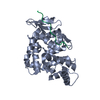
| ||||||||
|---|---|---|---|---|---|---|---|---|---|
| 1 |
| ||||||||
| Unit cell |
|
- Components
Components
| #1: Protein/peptide | Mass: 1746.036 Da / Num. of mol.: 1 / Source method: obtained synthetically Details: This peptide was chemically synthesized and occurs naturally in Homo Sapiens (Human) References: UniProt: Q14118 |
|---|---|
| #2: Protein | Mass: 29845.232 Da / Num. of mol.: 1 / Fragment: WW DOMAIN Source method: isolated from a genetically manipulated source Source: (gene. exp.)  Homo sapiens (human) / Plasmid: PGEX-2TK / Production host: Homo sapiens (human) / Plasmid: PGEX-2TK / Production host:  |
| #3: Water | ChemComp-HOH / |
-Experimental details
-Experiment
| Experiment | Method:  X-RAY DIFFRACTION / Number of used crystals: 2 X-RAY DIFFRACTION / Number of used crystals: 2 |
|---|
- Sample preparation
Sample preparation
| Crystal | Density Matthews: 2.16 Å3/Da / Density % sol: 43.17 % | ||||||||||||||||||||||||||||||||||||||||||||||||||||||
|---|---|---|---|---|---|---|---|---|---|---|---|---|---|---|---|---|---|---|---|---|---|---|---|---|---|---|---|---|---|---|---|---|---|---|---|---|---|---|---|---|---|---|---|---|---|---|---|---|---|---|---|---|---|---|---|
| Crystal grow | Temperature: 298 K / Method: vapor diffusion, hanging drop / pH: 7 Details: ammonium sulfate, glycerol, DTT, pH 7.0, VAPOR DIFFUSION, HANGING DROP, temperature 298K | ||||||||||||||||||||||||||||||||||||||||||||||||||||||
| Crystal grow | *PLUS Temperature: 22 ℃ / pH: 6.5 | ||||||||||||||||||||||||||||||||||||||||||||||||||||||
| Components of the solutions | *PLUS
|
-Data collection
| Diffraction | Mean temperature: 213 K |
|---|---|
| Diffraction source | Source:  SYNCHROTRON / Site: SYNCHROTRON / Site:  APS APS  / Beamline: 19-ID / Wavelength: 1.07 / Beamline: 19-ID / Wavelength: 1.07 |
| Detector | Type: APS-1 / Detector: CCD / Date: Apr 12, 1999 |
| Radiation | Protocol: SINGLE WAVELENGTH / Monochromatic (M) / Laue (L): M / Scattering type: x-ray |
| Radiation wavelength | Wavelength: 1.07 Å / Relative weight: 1 |
| Reflection | Resolution: 1.9→25 Å / Num. all: 120237 / Num. obs: 21895 / % possible obs: 98.3 % / Observed criterion σ(I): -3 / Redundancy: 5.5 % / Biso Wilson estimate: 24 Å2 / Rmerge(I) obs: 0.052 / Net I/σ(I): 12.6 |
| Reflection shell | Resolution: 1.9→1.97 Å / Redundancy: 5 % / Rmerge(I) obs: 0.295 / Num. unique all: 2146 / % possible all: 95.3 |
| Reflection | *PLUS Num. measured all: 120237 |
- Processing
Processing
| Software |
| |||||||||||||||||||||||||
|---|---|---|---|---|---|---|---|---|---|---|---|---|---|---|---|---|---|---|---|---|---|---|---|---|---|---|
| Refinement | Resolution: 2→20 Å / σ(F): 2 / Stereochemistry target values: Engh & Huber
| |||||||||||||||||||||||||
| Refinement step | Cycle: LAST / Resolution: 2→20 Å
| |||||||||||||||||||||||||
| Refine LS restraints |
| |||||||||||||||||||||||||
| Software | *PLUS Name:  X-PLOR / Version: 3.1 / Classification: refinement X-PLOR / Version: 3.1 / Classification: refinement | |||||||||||||||||||||||||
| Refinement | *PLUS Highest resolution: 2 Å / Lowest resolution: 20 Å / σ(F): 2 / Rfactor obs: 0.197 | |||||||||||||||||||||||||
| Solvent computation | *PLUS | |||||||||||||||||||||||||
| Displacement parameters | *PLUS |
 Movie
Movie Controller
Controller




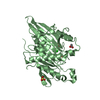
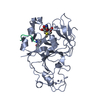
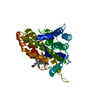

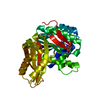
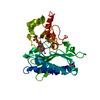
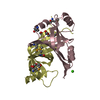
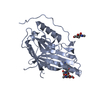
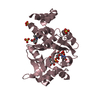
 PDBj
PDBj




